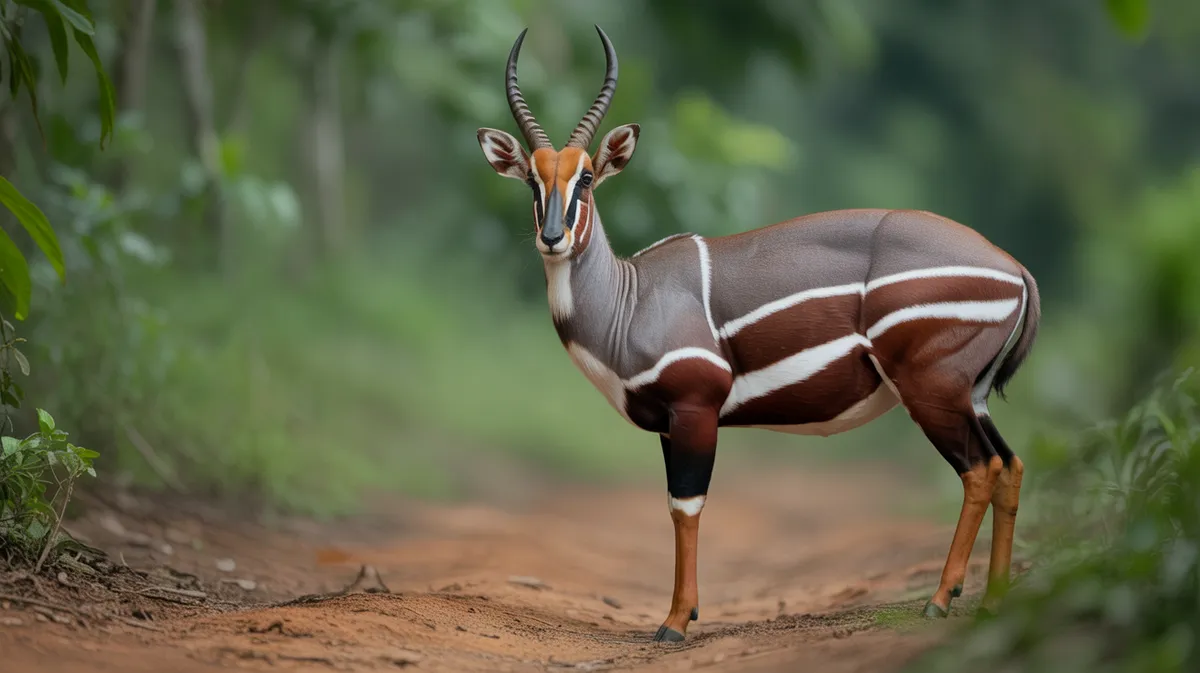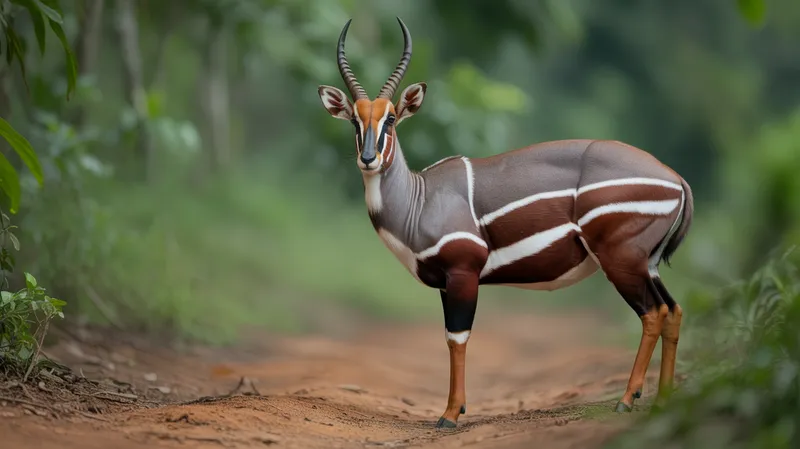
Royal Antelope
Neotragus pygmaeus

Meet the Royal Antelope
The Royal Antelope is the smallest antelope species in the world, native to the dense, humid forests of West Africa. Adults stand only about 25 centimeters (10 inches) at the shoulder and are characterized by their delicate, slender legs and reddish-brown coat with a white underbelly. Despite their tiny size, they are agile and can leap impressive distances to escape predators. Their nocturnal and secretive nature makes them seldom seen in the wild, and they are highly adapted to moving silently through thick vegetation.
Classification
Mammal
Habitat
Tropical lowland forest
Diet
Herbivore
Lifespan
6-8 years
Conservation
Least Concern
Weight
1.5–2.5 kg
📖Fascinating Facts
World’s Smallest Antelope
The Royal Antelope holds the title of the smallest living antelope species, measuring just 40–50 cm in length and standing less than 30 cm tall at the shoulder.
Nocturnal and Elusive
This antelope is primarily nocturnal, emerging at dusk to feed and using its agility and speed to avoid predators.
Forest Specialist
It is highly specialized for life in dense, lowland forests, rarely venturing into open spaces where it would be more vulnerable.
📋Detailed Description
The royal antelope (Neotragus pygmaeus) is the smallest extant antelope species, with adults typically standing 20–25 cm at the shoulder and weighing between 2.5 and 3 kg. Its body is compact and delicate, with an elongated head, large dark eyes, and a pointed muzzle, features that enhance its ability to navigate dense undergrowth. The pelage is a rich reddish to golden brown dorsally, sharply contrasting with the white underparts and inner legs, providing effective camouflage in dappled forest light. The limbs are notably slender and elongated, especially the hind legs, which are nearly twice as long as the forelegs, enabling remarkable leaping ability—individuals can clear horizontal distances of up to 2.5 meters in a single bound. Only males possess horns, which are short (2.5–3 cm), smooth, and backward-curving, often hidden in the fur. The ears are relatively large and mobile, aiding in acute detection of predators. The species has a small mouth and reduced cheek musculature, reflecting its diet of soft, easily digestible plant matter. Royal antelopes are primarily nocturnal and crepuscular, emerging at dusk to forage and relying on their cryptic coloration and silent movement for predator avoidance. They are solitary or found in monogamous pairs, exhibiting strong territoriality, with individuals marking their ranges using preorbital gland secretions. Their secretive habits and preference for dense cover make them difficult to observe in the wild.
💡 Did you know?
Despite being antelopes, Royal Antelopes do not form herds and are usually seen alone or in monogamous pairs.
🔬Research & Sources
Wikipedia Summary
The royal antelope is a West African antelope recognized as the world's smallest. It was first described by Swedish zoologist Carl Linnaeus in 1758. It stands up to merely 25 cm (10 in) at the shoulder and weighs 2.5–3 kg (5.5–6.6 lb). A characteristic feature is the long and slender legs, with the hindlegs twice as long as the forelegs. Horns are possessed only by males; the short, smooth, spiky horns measure 2.5–3 cm (0.98–1.18 in) and bend backward. The soft coat is reddish to golden brown, in sharp contrast with the white ventral parts. In comparison to Bates's pygmy antelope, the royal antelope has a longer muzzle, broader lips, a smaller mouth and smaller cheek muscles.
Last Modified: 3/5/2025
🎭Behavior & Social Structure
Royal antelopes are highly elusive and predominantly nocturnal, with peak activity occurring during twilight and nighttime hours. They spend daylight hours resting in dense thickets or among buttress roots, minimizing exposure to predators. Foraging is solitary, with individuals browsing on tender leaves, shoots, fallen fruits, and occasionally fungi, selecting food items low to the ground. They employ a 'freeze-and-bolt' strategy when threatened, remaining motionless to avoid detection before making rapid, bounding escapes. Territorial boundaries are maintained by both sexes, with males being especially aggressive toward intruders. Scent marking with preorbital gland secretions and fecal piles is common. Social interactions are limited outside of the breeding season, though pairs may share overlapping territories. Vocalizations are rare; communication is primarily olfactory and visual, with tail flicking and body posture used in signaling.
👶Reproduction & Life Cycle
Royal antelopes exhibit a monogamous or solitary mating system, with breeding occurring year-round but peaking during the rainy season when food is most abundant. Courtship involves subtle following and sniffing behaviors, and males may engage in brief chases. After successful mating, females undergo a gestation period of approximately 170–174 days (about 5.5–6 months), typically giving birth to a single offspring. Neonates are well-camouflaged, weighing around 1 kg at birth, and are hidden in dense vegetation for the first weeks of life. The mother visits the fawn briefly for nursing, minimizing scent trails to avoid attracting predators. Weaning occurs at about 2–3 months, with juveniles reaching sexual maturity at 6–8 months. Parental care is provided solely by the female, with no involvement from the male after mating.
🛡️Adaptations & Survival
The royal antelope possesses several key adaptations for survival in dense West African forests. Its diminutive size and cryptic coloration allow it to move undetected through thick undergrowth. The elongated hind limbs confer exceptional leaping ability, enabling rapid escape from ground predators such as civets, genets, and snakes. Large, mobile ears provide acute hearing, compensating for limited visibility in the forest understory. The small mouth and reduced cheek musculature are specialized for selective browsing on soft, nutrient-rich plant material. Nocturnality reduces predation risk and competition for food. Scent-marking and territoriality help minimize intraspecific conflict and ensure access to limited resources. The species' reproductive strategy, with hidden, well-camouflaged young, further enhances offspring survival in a predator-rich environment.
📚Research Sources
🎨Cultural Significance
The royal antelope holds a modest place in West African folklore, often symbolizing agility, shyness, and the spirit of the forest. Its diminutive size and elusive nature have led to its mention in local tales as a creature of mystery and subtlety. While not a major target for traditional medicine or ritual use, it is occasionally hunted for bushmeat. In some regions, its presence is considered an indicator of healthy, undisturbed forest, and it is sometimes featured in conservation education as a flagship species for forest protection.
🔬Recent Research & Discoveries
Recent research has focused on refining the taxonomy of Neotragus, with molecular studies confirming the royal antelope as the sole member of its genus, distinct from closely related pygmy antelopes. Camera trapping and genetic sampling are increasingly used to estimate population densities and assess genetic diversity, revealing that populations are often highly fragmented. Studies on diet and habitat use have highlighted the species' reliance on intact, undisturbed forest, underlining its vulnerability to habitat alteration. Ongoing research aims to clarify reproductive biology, home range size, and responses to habitat fragmentation, with the goal of informing more effective conservation strategies.
🎥Wildlife Videos

The Most Beautiful and Rare Antelope Species on Earth
The Most Beautiful and Rare Antelope Species on Earth.
Ritoso

Top 10 Fascinating Facts About Antelopes You Need to Know 🦌 | Animalia Insights TV
Discover the Top 10 Interesting Facts About Antelopes that will blow your mind! From their lightning-fast speeds to their ...
Animalia Insights TV

Antelopes Nature’s Graceful Creatures
Antelopes are Captivating animals that live mostly in the grasslands, savannas, and forests of Africa and parts of Asia. With over ...
Plus Nature

🦌 Antelopes: The Olympic Runners of the Animal Kingdom
Mr. Whale: “If anxiety were an animal, it'd be the antelope.” Alice: “They've got legs for days—and predators on speed dial!
Whale Telling

ANTELOPE
Antelope, any of numerous Old World grazing and browsing hoofed mammals belonging to the family Bovidae (order Artiodactyla) ...
🌺AMAZING NATURE 21🌺

Antelope Marvels in Mesmerizing 4K Beauty! 🦌✨ Nature's Elegance Unveiled! Animal world
Antelopes are a diverse group of typically hollow-horned, slender-built, and swift bovids native to Africa and Asia. Antelope ...
Animal world
🌍Habitat Information
The Royal Antelope typically inhabits Tropical lowland forest environments. Royal Antelopes have adapted to their environments with specialized features and behaviors.
Primary Habitat:
Tropical lowland forest
More detailed habitat information will be available soon.
🛡️Conservation Status
The Royal Antelope is currently classified as Least Concern. Conservation efforts are crucial for preserving this species for future generations.
Common Threats:
- 🏠Habitat loss and fragmentation
- 🌡️Climate change impacts
- 🎯Hunting and poaching
- 🏭Human-wildlife conflict
⚠️Threats & Conservation Challenges
Although currently listed as Least Concern by the IUCN, the royal antelope faces several significant threats. Habitat loss and fragmentation due to logging, agricultural expansion, and human settlement are the primary challenges, reducing suitable forest cover and isolating populations. Hunting for bushmeat, both for local consumption and commercial markets, poses an additional threat, particularly in areas with high human density. The species' secretive nature and low population densities make it difficult to monitor, raising concerns about undetected declines. Climate change may also impact forest structure and food availability. Conservation efforts are hampered by limited ecological data and the species' elusive habits, emphasizing the need for targeted research and habitat protection.
🔬Scientific Classification
Scientific Name
Neotragus pygmaeus
Classification Hierarchy
🔍 About Taxonomic Classification
Taxonomic classification is a hierarchical system used by scientists to classify and organize living organisms based on shared characteristics and evolutionary relationships.
The system moves from broad categories (Kingdom) to increasingly specific ones, with each animal's scientific name typically consisting of its Genus and species.
📝Community Notes
Share your observations and insights about the Royal Antelope with our community of wildlife enthusiasts.
Join Our Community
Sign in to share your observations and connect with fellow wildlife enthusiasts.
Sign In to ContributeNo community notes yet
Be the first to share your observations about the Royal Antelope!
Explore Royal Antelope
Select a tab above to learn more about this amazing animal.
📸Photo Gallery
No photos available for this animal yet.
🌟Discover More Wildlife
Continue your journey of discovery with more fascinating animals from our database
